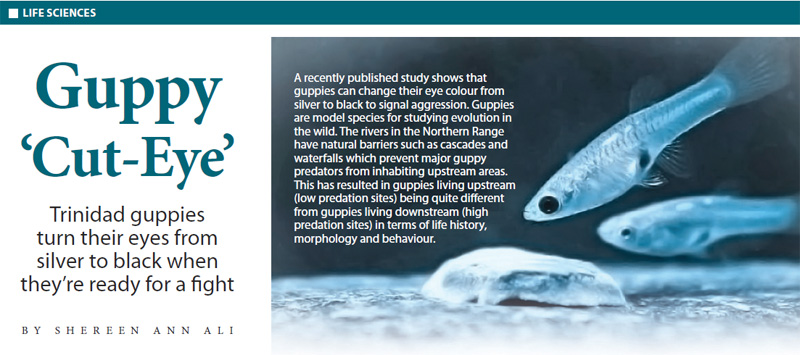 |
 |
 |
|
July 2018 |
Suppose you meet a mortal enemy and combat seems imminent. What if, then, your eyes suddenly turned an inky-black colour, to signal to the enemy that you’re a powerful warrior who can easily whip him in a fight? That, in a nutshell, is what the humble Trinidad guppy does when it’s getting ready to rumble, especially if other guppies or other fish are threatening to steal its valuable food. A study led by the University of Exeter, in collaboration with the University of the West Indies, found that when facing a rival, guppies rapidly turn their irises from silver to black before attacking their adversary. In TT creole culture, you could humorously say it’s like the guppy version of “cut-eye.” It’s a built-in biological mechanism that helps the tiny fish communicate its aggression. The guppy eye colour change makes their eyes more conspicuous and is an “honest” signal of aggression – larger guppies do it to smaller ones whom they can beat in a fight, but smaller ones do not return the gesture, say University of Exeter researchers. Our own UWI St Augustine Deputy Principal, Professor Indar Ramnarine, was part of this research team and co-author of the recently published paper on the guppy eye change, called “Dynamic eye colour as an honest signal of aggression”, and published in the journal Current Biology. The Exeter team is one of several research teams from different universities around the world with whom Prof Ramnarine works, pursuing different projects. Ramnarine is Professor of Fisheries and Aquaculture at the UWI Department of Life Sciences. In a recent interview with UWI Today, he said: “I’ve been collaborating with Professor Darren Croft from the University of Exeter for the past 15 years. Dr Robert Heathcote, lead author of the study and from the University of Exeter, joined the research group about four years ago. The fascinating characteristic about guppies is that they are an ideal model to study evolution. Females mature in just 10 weeks while males take seven weeks. And they can live for about four years. That means there is a quick turnover, with lots of generations to study.” “Guppies are native to North-East South America and Trinidad, with the males being smaller and more colourful than the females. In Trinidad’s Northern Range, there are natural barriers such as cascades, and these separate two distinct guppy populations that behave differently. Above the cascade barriers, there are hardly any natural predators, and guppies here mature later in life, have fewer baby guppies per pregnancy, and these young are large. Below the natural barriers, the guppies encounter many more predators – mainly the matawal or pike cichlid, and the guabine or wolf-fish – and these guppies mature much earlier in life, and have large numbers of live young which are smaller in size than guppies in the safer waters upstream.”
Heathcote with his colleague Jolyon Troscianko had the idea to build latex models of guppies. Troscianko studies animal camouflage. Science writer Ed Young clearly describes the process of building the simulated guppies in his lively June 4 article in The Atlantic magazine: “The team pressed a dead fish into some resin to make a silicon mold that could churn out model guppies. They then photographed live fish with black and silver eyes, recalibrated the images for guppy vision, and printed them onto sheets of clingfilm. They stretched the coloured sheets over the silicone models, which they attached to a fishing line on a motor.” And just like that, they had great imitation guppies which could be made to defend and thrash over a bit of food. Dr Robert Heathcote said of the study: “Experimentally showing that animals use their eye coloration to communicate with each other can be very difficult, so we made realistic-looking fish with differing eye colours and observed the reaction of real fish….Trinidadian guppies can change their iris colour within a few seconds, and our research shows they do this to honestly communicate their aggressive motivation to other guppies.” Professor Darren Croft added: “Eyes are one of the most easily recognised structures in the natural world and many species go to great lengths to conceal and camouflage their eyes to avoid unwanted attention from predators or rivals. However, some species have noticeable or prominent eyes and, for the most part, it has remained a mystery as to why this would be. This research gives a new insight into the reasons behind why some animals have such ‘conspicuous’ eyes.” Dr Safi Darden co-author on the study added: “It is well known that in humans the white sclera of the eye is used to signal gaze direction – it provides others with information on what we are looking at. Our work shows that just like humans, these little fish pay attention to the eyes of their group members and that the eyes provide important information to other rival fish”. Prof Ramnarine comments: “Different animals respond differently to threats. A pufferfish, for instance, takes in water or air to make itself seem huge; other animals also make themselves seem larger or fierce. It’s an important strategy in the animal kingdom when creatures come into conflict with each other. This guppy study shows that fish can evolve a complex behavioural strategy to communicate with other fish that they are willing to fight.” The research paper “Dynamic eye colour as an honest signal of aggression” was published in the journal Current Biology, Volume 28, Issue 11, on June 4, 2018, and was based on research done in 2016 and 2017. Its authors are Robert J.P. Heathcote, Safi K. Darden, Jolyon Troscianko, Michael R.M. Lawson, Antony M. Brown, Philippa R. Laker, Lewis C. Naisbett-Jones, Hannah E.A. MacGregor, Indar W, Ramnarine, and Darren P. Croft. |


 “Darren (Croft) and I were in the lab one day and we noticed the iris colour change from silver to black and thought, there must be a reason. Then Dr Robert Heathcote joined the team and led this study.”
“Darren (Croft) and I were in the lab one day and we noticed the iris colour change from silver to black and thought, there must be a reason. Then Dr Robert Heathcote joined the team and led this study.”